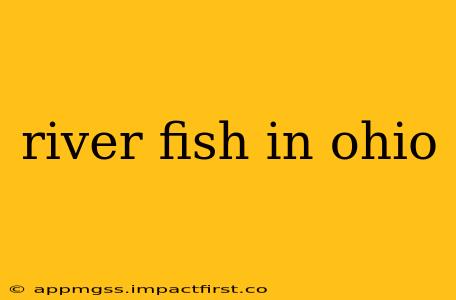Ohio boasts a diverse range of fish inhabiting its many rivers, from the mighty Ohio River to smaller tributaries. Anglers and nature enthusiasts alike can find a wealth of aquatic life to explore. This guide delves into the common river fish found in Ohio, their habitats, and some interesting facts. Understanding the fish populations helps us appreciate and protect these valuable natural resources.
What are some common river fish found in Ohio?
Ohio's rivers are home to a wide variety of fish species. Some of the most common include:
-
Largemouth Bass: A highly sought-after game fish, the largemouth bass thrives in slower-moving waters with ample vegetation. They're ambush predators, known for their powerful strikes.
-
Smallmouth Bass: Preferring clearer, faster-flowing rivers with rocky bottoms, smallmouth bass are another popular game fish in Ohio. They're known for their aggressive feeding habits and acrobatic fights.
-
Channel Catfish: A bottom-dwelling species, channel catfish are incredibly common throughout Ohio's rivers. They are scavengers and can grow to impressive sizes.
-
Bluegill: These panfish are a favorite among anglers, particularly those seeking a relaxing day of fishing. They inhabit shallow, vegetated areas of rivers.
-
Crappie (Black and White): Both black and white crappie are prevalent in Ohio's rivers. These panfish prefer areas with submerged structures and woody cover.
-
Carp: Often considered a nuisance species by some, carp are nonetheless a plentiful fish in Ohio's rivers. They are bottom feeders, known for their strong fighting ability.
-
Walleye: While more associated with lakes, walleye can also be found in certain sections of Ohio's larger rivers, particularly those with clearer, deeper waters.
-
Muskie: A true trophy fish, the muskie is a powerful predator found in some of Ohio's larger, less polluted rivers. They require pristine habitats.
What is the best time of year to fish for river fish in Ohio?
The best time to fish for river fish in Ohio varies depending on the species you're targeting. Generally, spring and fall offer comfortable temperatures for both anglers and fish, often resulting in increased activity. Summer can be productive early in the morning or late in the evening, while winter fishing is often best done in deeper, slower-moving sections of the river. Always check local fishing regulations and consider water temperature and weather conditions when planning your fishing trip.
What are the best rivers in Ohio for fishing?
Many Ohio rivers offer excellent fishing opportunities. The Ohio River itself, with its vast size and diverse habitats, provides abundant fishing. Other notable rivers include the Muskingum, Scioto, and Maumee rivers, each offering different species and fishing experiences. Research specific river sections to find the best locations for targeting your desired fish.
What are some tips for fishing for river fish in Ohio?
- Obtain a fishing license: Ensure you have the necessary Ohio fishing license before heading out.
- Check fishing regulations: Familiarize yourself with size and bag limits for the species you plan to target.
- Use appropriate gear: Select tackle suitable for the type of fish you're after, and the river conditions.
- Be aware of water levels and currents: River levels and currents can change rapidly, impacting fishing conditions.
- Practice catch and release: Consider practicing catch and release to help maintain healthy fish populations.
What kind of bait is best for catching river fish in Ohio?
The best bait depends on the species you're targeting. Live bait such as minnows, crayfish, and worms often works well. Artificial lures, such as spinnerbaits, crankbaits, and jigs, can also be highly effective. Experiment with different baits and techniques to find what works best in the specific location and conditions.
Are there any endangered or threatened river fish in Ohio?
While many fish species thrive in Ohio's rivers, some are endangered or threatened. These species often require specific habitat conditions and are sensitive to pollution or habitat destruction. Protecting these vulnerable fish requires careful conservation efforts. Check with the Ohio Department of Natural Resources for the latest information on endangered or threatened species in Ohio rivers.
By understanding the diversity of Ohio's river fish and practicing responsible fishing techniques, we can help ensure the health and sustainability of these vital aquatic ecosystems for generations to come. Remember to always follow local regulations and prioritize conservation efforts.
